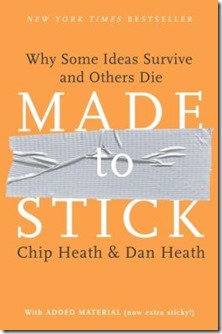Two Speech Gimmicks That Worked (And One That Didn't)
Wikipedia defines a gimmick as “a trick or device intended to attract attention, publicity, or business.” For the purposes of this post, I’ll define gimmick slightly differently—as an unusually theatrical device intended to make a speaker’s point much more memorable.
Because gimmicks are so attention grabbing, they fall under the category of “high risk, high reward.” When they work, they’re brilliant and become the one moment the audience remembers more than any other. But the opposite is also true: When they fail, they become the one moment the audience remembers more than any other.
As an example of a gimmick that worked, I once consulted with a scientist who was about to deliver a major talk about The Dark Ages. He described that period in great detail, explaining that the darkness was absolute, beyond any darkness that humans living today have ever experienced.
It occurred to me that killing the room lights could help the audience visualize that period even better, transporting them into the period of darkness better than his words alone ever could. We timed the moment to match his narration—and when the right moment struck, we killed the lights. For two minutes, he explained The Dark Ages to an audience that couldn’t see their own hands.
That moment worked well because the “gimmick” was tied directly to his message. It seized the audience’s attention at the exact moment that he had a strong takeaway message to deliver. Most importantly, it felt purposeful and sincere, not gratuitous and manipulative.
Another Gimmick That Worked Well
The excellent book Made to Stick tells the story of Geoff Ainscow, an advocate who lobbied for arms control. The problem he encountered during his talks was that his audiences weren’t moved by his presentation. He found himself unable to convey the scale of the problem through statistics alone.
He changed tactics. To make his point, he dropped a BB into an empty bucket and compared it to Hiroshima. What came next had a huge impact. The authors write:
“Next, he’d drop ten BBs into the bucket. The clatter was louder and more chaotic. ‘This is the firepower of the missiles on one U.S. or Soviet nuclear submarine,’ he’d say.
Finally, he asked the attendees to close their eyes. He’d say, ‘This is the world’s current arsenal of nuclear weapons.’ Then he poured 5,000 BBs into the bucket (one for every nuclear warhead in the world). The noise was startling, even terrifying. ‘The roar of the BBs went on and on,’ said Ainscow. ‘Afterward there was always dead silence.”
An Awful Gimmick
An example of a gimmick that didn’t work comes from Jeremey Donovan’s book How To Deliver a TED Talk. Discussing a speaker he had recently seen, he writes:
“To kick off his presentation, he asks his audience to stand up, put their hand on their heart, turn around, and take one step forward. He then goes on to say that he can now report to his own boss when asked how the presentation went, that he ‘got them on their feet, touched their hearts, turned them around, and got them moving in the right direction.’”
Ugh! Donovan describes the change in that audience’s body language, which clearly reflected their resentment at having been manipulated purposelessly.
My general advice regarding gimmicks is this: They should be meaningful, tied directly to the message, and delivered by a sincere speaker who truly believes in the tactic. If you follow that guidance, don’t be afraid to use an occasional gimmick.
Like the blog? Read the book! The Media Training Bible: 101 Things You Absolutely, Positively Need to Know Before Your Next Interview is available in paperback, for Kindle, and iPad.





Can I suggest a third category Brad? A gimmick which is not directly related to a point but which contributes to the general impression of the speaker and the presentation. There’s a great example of that kind of gimmick in the Ted talk:
http://www.ted.com/talks/hans_and_ola_rosling_how_not_to_be_ignorant_about_the_world
I won’t spoil it, but in a great little talk there is one moment completely unrelated to the talk, that I found absolutely hilarious and which I thought worked very well.
John
PS Is that a small typo in the quote above? Should it be “touched their hearts?”
Hi John,
Thanks very much for sharing that link. I’m a fan of Hans Rosling’s but haven’t seen this clip — so I look forward to watching it! And for readers of this blog, you’re in for a treat if you’ve never seen Rosling speak before.
Also, thanks for pointing out the typo. It’s fixed.
Best,
Brad